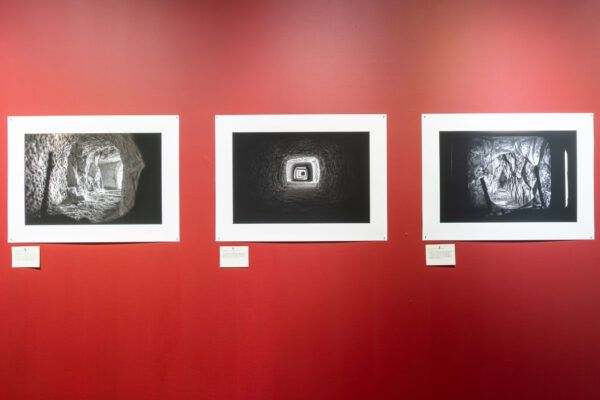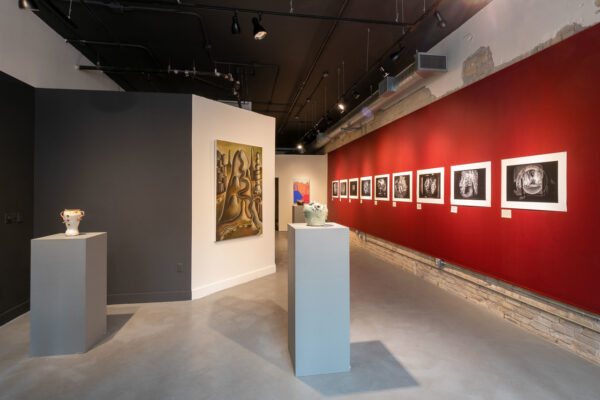Emma Hadzi Antich wears a key around her neck in case she finds the lock it belongs to. The Austin-based artist, with her painterly penchant for all things Byzantine, once constructed a colorful wooden “sybil” for an outdoor project, but the sybil went missing — lock, box, and the little paper fortunes it contained. Years later, she still wears the key in case it turns up. “If I find it and can unlock it,” she sighs, “then it’s mine again.”
So goes the theme of Going Down, a group show at Northern-Southern in Austin about the keyholes (and tunnels and portals) that connect this world to the next. Hadzi Antich is one of five participating artists in Going Down, which gallery owner Phillip Niemeyer has dubbed “an art show about hell holes.” But it’s more of an ode to the Underworld: Orpheus en route to Eurydice before the poor fool returns home empty handed.

Installation of view of “Blanche” (2023) and “Elio” (2023) by Charles Degeyter. Photo by Tyeschea West.
Two taxidermied songbirds in tiny sarcophagi greet visitors upon entering the gallery, as images of ancient ruins and urns placed on pedestals conjure mythic tales of the dead and gone. Charon gets in on the action with a tabletop game named in his honor. The Underworld isn’t so bad if you play your hand right.
Two of Hadzi Antich’s paintings tackle the unfinished business of her missing sybil; in one panel, a woman holds a slender gold key, and in the other, the woman rests beside a floating keyhole. Both paintings feature a lone pillar with no apparent structure to support. “The pillars, in architecture, especially in Greek architecture, are there to hold things up. They have a purpose,” she tells me. “But these pillars are purposeless.” Purposeless pillars (much like keys without locks) struggle for meaning when the other half is missing.
Hadzi Antich, a self-taught painter who majored in political philosophy in lieu of art history, wants to bring both halves back together. By fusing ancient myth and modern motifs, she creates serene Byzantine figurations that revamp the fallen empire with a fresh new look. “Late Antiquity is a nice foil for where we find ourselves in post-modernity,” she tells me. “The Byzantines thought the body was disgusting and wanted to strip it, whip it, and stamp it into the ground. But now we think of religion as so cringe and focus on our physical comforts instead — so you’ve got these two worlds, these two eras, that only acknowledge half of the human being.”
Alyssa Taylor Wendt’s Charon’s Folly examines both halves by carefully weighing each side. The artist has placed a traditional scale on a ceremonial table that instructs participants to remove an object from one of its two plates and replace it with an item on the table of equal weight. Failure to do so, notes Wendt, incurs a heavy debt that remains long after the game is over. To drive that last point home, the artist has included several ceramic urns in the main gallery space; when I peek inside one of them (the vessels are open on top with brass peepholes on the side) an eerie little mise en scène involving a gaggle of grim reapers serves as a reminder of unpaid debts.
Along the main wall, a series of black and white photos by Christos Pathiakis takes us to the physical entranceways of two separate underworlds — Hades and Xibalba — which are accompanied by excerpts from an apocryphal travelog, only recently “discovered” by the artist himself. In his fictional rendering of an 1870 archeological expedition, Pathiakis documents a harrowing journey to the southern tip of Greece in search of the opening to Hades. The second half of the series brings us to British Honduras (now Belize), with images of temples overtaken by the jungle: “We can only marvel at the size and artistry of the lost metropolis, a rival to those of ancient Greece and Egypt.” Three of the photographs can also be viewed through “magic lanterns” constructed by Pathiakis, containing slide film from over a century ago (around the time of said expedition), for a mysterious glimpse into ancient cultures and mythic realms.
Jaime Zuverza’s untitled landscape painting touches on another world, if not the Underworld. Geometric forms rise up in a strange topography of stalagmites, as a ribbon of road leads down from the central hilltop into a wide canyon. Not quite Hades, but moving in that general direction.
There seems to be a consensus among the five artists that all of this leads to the same place, finely underlined by Belgian artist Charles Degeyter’s tiny pair of dead birds, resting in custom-made coffins made using a 3D printer. The bright dead creatures — one yellow, one white — were shipped from Belgium specifically for this show.
“Why these two for Going Down?” I ask gallery owner Phillip Niemeyer.
“Because they aren’t going up anymore.”
Going Down is on view through February 18, 2023 at Northern-Southern in Austin.






